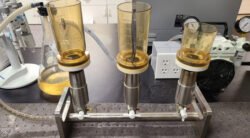
Deer Island Sewage Treatment Plant
Deer Island Sewage Treatment Plant is located in Boston Harbor, Massachusetts, and is one of the largest treatment plants in the United States. It serves the Greater Boston area and treats wastewater from over 40 communities, including Boston, Cambridge, and Quincy.
History of Deer Island
The history of Deer Island dates back to the early 1600s when it was used as a fishing and farming community. In the 1800s, the island became home to a poorhouse and hospital, and in the early 1900s, a prison was built on the island. In the mid-20th century, the island was designated as a site for a sewage treatment plant to address the growing pollution problem in Boston Harbor.
Construction of the sewage treatment plant began in the 1950s, and the facility was completed and operational by the early 1960s. Over the years, the plant has undergone several expansions and upgrades to increase its capacity and efficiency in treating wastewater. Today, Deer Island Sewage Treatment Plant is a state-of-the-art facility that utilizes advanced technology to clean and process millions of gallons of wastewater each day.
Treatment Process
Deer Island Sewage Treatment Plant utilizes a multi-step process to treat wastewater and remove contaminants before discharging the treated water back into the environment. The treatment process includes the following steps:
1. Screening: Wastewater enters the plant and passes through screens to remove large debris, such as sticks, leaves, and plastic items.
2. Primary Treatment: The screened wastewater is sent to settling tanks where solids settle to the bottom and grease and oils float to the top. These solids are removed and sent to digesters for further processing.
3. Secondary Treatment: The liquid portion of the wastewater is then treated using biological processes to remove organic matter and nutrients. This step helps to further clean the water before it is discharged.
4. Tertiary Treatment: In some cases, the treated water may undergo additional treatment to remove any remaining contaminants, such as pathogens or chemicals. This step ensures that the water meets strict environmental standards before it is released back into the environment.
5. Disinfection: Before the treated water is discharged, it is disinfected using chlorine or ultraviolet light to kill any remaining bacteria or pathogens.
Effluent Discharge
Once the wastewater has been treated and cleaned, the effluent is discharged into Boston Harbor through a series of outfall pipes located offshore. These outfall pipes are designed to safely and effectively release the treated water back into the environment without causing harm to marine life or ecosystems.
Deer Island Sewage Treatment Plant plays a crucial role in protecting the environment and public health by treating and cleaning wastewater before it is discharged into Boston Harbor. The plant’s advanced treatment processes help to remove contaminants and pollutants from the water, ensuring that it meets strict environmental standards set by regulatory agencies.
By cleaning wastewater before it is released into the environment, Deer Island Sewage Treatment Plant helps to prevent pollution, reduce the spread of disease, and protect marine life and ecosystems in Boston Harbor. The plant’s efforts have led to significant improvements in water quality and environmental conditions in the harbor, making it a healthier and more sustainable ecosystem for all to enjoy.
Community Outreach
Deer Island Sewage Treatment Plant is committed to engaging with the community and raising awareness about the importance of wastewater treatment and environmental stewardship. The plant offers educational programs, tours, and events for students, teachers, and community groups to learn more about wastewater treatment and the role it plays in protecting the environment.
The plant also participates in outreach and education efforts to promote water conservation, pollution prevention, and sustainable practices in the community. By working together with local residents, businesses, and organizations, Deer Island Sewage Treatment Plant strives to create a cleaner, healthier, and more sustainable environment for all.
Future Plans
As population growth and urban development continue to increase in the Greater Boston area, the demand for wastewater treatment services is expected to grow. Deer Island Sewage Treatment Plant is constantly evaluating and planning for future upgrades and expansions to meet the needs of the community and ensure that it can continue to provide clean and safe water for years to come.
The plant is exploring new technologies and innovative solutions to improve the efficiency and effectiveness of its treatment processes, reduce energy consumption and carbon emissions, and enhance its overall environmental performance. By investing in sustainable practices and cutting-edge technologies, Deer Island Sewage Treatment Plant is paving the way for a more resilient and environmentally friendly future.
Conclusion
Deer Island Sewage Treatment Plant is a critical infrastructure that plays a vital role in protecting public health and the environment in the Greater Boston area. Through its advanced treatment processes, the plant helps to clean and process millions of gallons of wastewater each day, ensuring that it meets strict environmental standards before being released back into the environment.
The plant’s commitment to community outreach and education, environmental stewardship, and innovation positions it as a leader in the field of wastewater treatment and environmental protection. By working together with the community and investing in sustainable practices, Deer Island Sewage Treatment Plant is dedicated to creating a cleaner, healthier, and more sustainable future for all.

